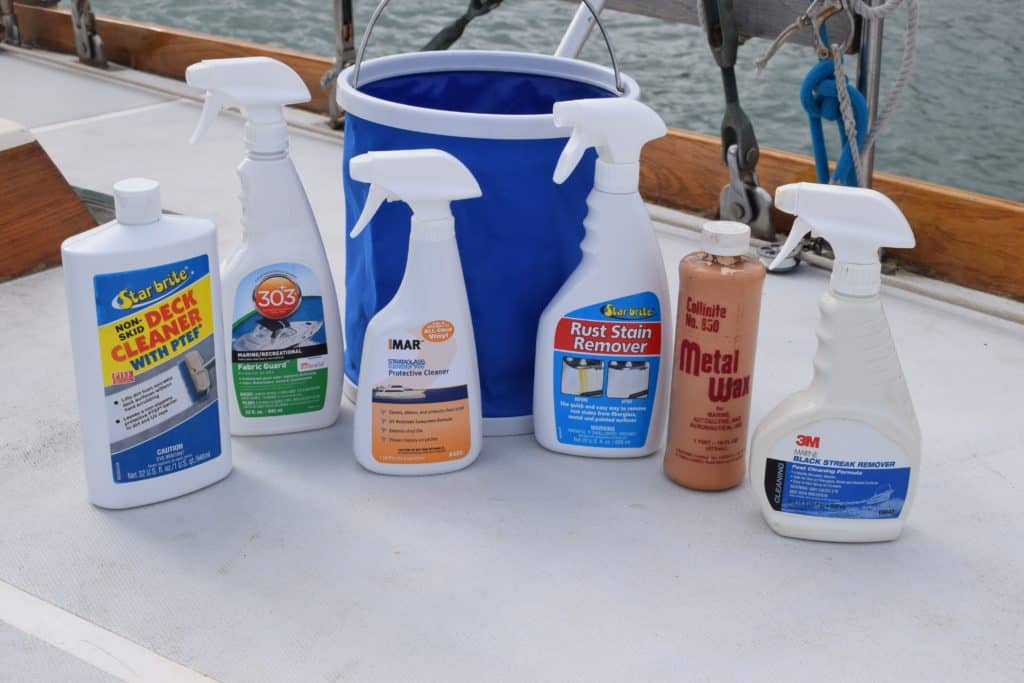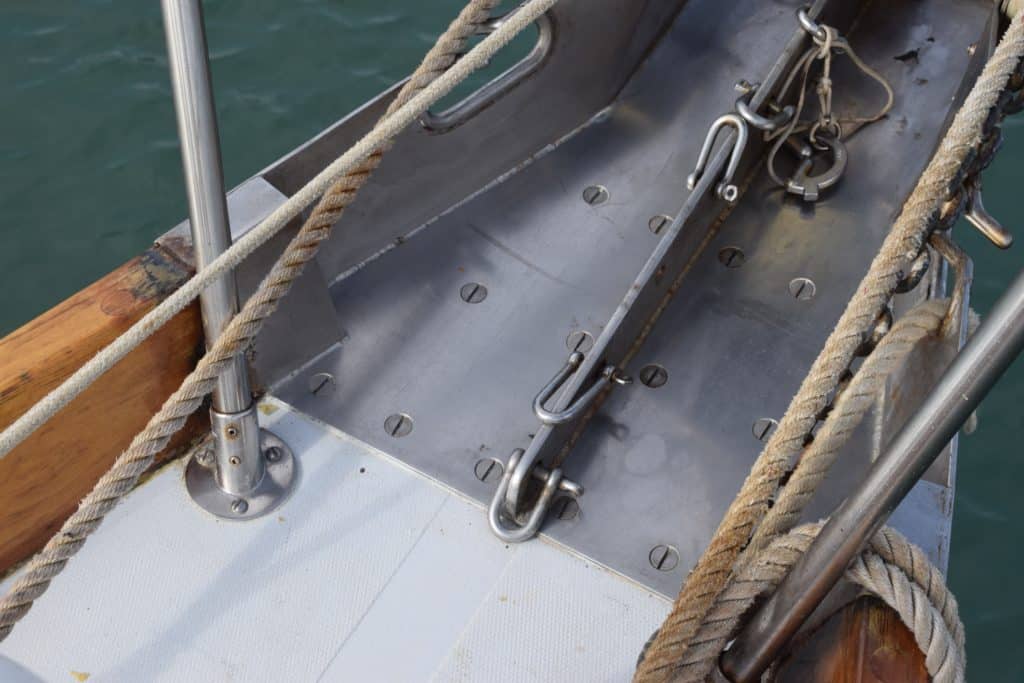
Our Reliance 44 ketch, Lyra, was fresh out of a two-week stint in the boatyard for some much-needed TLC. With a new paint job, she looked fantastic — well, the hull did anyway. On deck, she was showing the effects of heavy use over the summer, followed by a journey south for the winter. Add in a layer of boatyard grit, and there was plenty to do to get her deck looking as good as the rest of her. With my project needs in mind, I headed to West Marine for some supplies and then got to work. If a nautical detail job is on your spring to-do list, here are the areas to concentrate on and some products that will make your boat shine.
Start with a Scrub
If there has ever been one simple thing that has made my boat chores easier, it’s a collapsible bucket. If you’re like me and could never justify the space of a regular bucket on board, this very compact one is a great option.
In addition to the bucket, you’ll need a deck brush with medium-stiffness bristles, a hose with spray nozzle, and your choice of deck cleaner. While dish soap will get the job done, it will likely also strip any wax you might have on the deck or cabin top. For Lyra‘s “spa day,” I chose Star brite’s Non-Skid Deck Cleaner with PTEF. It did the job well, and supposedly leaves a barrier to protect against dirt and UV rays. Rinse well and let the deck dry before moving on to the next step.
Clean the Slate
Once the deck is free of salt and dirt, it’s time to work on the details. I started with several annoying rust stains, and for this I tried Star brite’s Rust Stain Remover. The results were startling — especially since I didn’t realize how bad the stains were until they were gone. The product is easy to use: Just spray, leave it for a few minutes, then rinse, and repeat as needed. Stubborn spots might need a little scrub. There were no problems using the spray on Lyra’s painted or gelcoat deck surfaces (patch-test first if you are concerned), and it was a pleasant surprise to see how effective it was on the surrounding stainless as well (which made the polishing step much easier — more on that in a minute).
If your boat’s deck has any other stubborn stains, now is the time to tackle them. Black streaks, which are caused mainly by pollutants in rainwater, are simple to remove with a specialized product such as 3M Marine Black Streak Remover. FSR is another popular cleanser that works well on a variety of fiberglass stains, although you want to make sure that you use gloves when applying it and do a test area first.
Lyra‘s white dorade covers tend to get stained, and the easiest way I have found to clean them is with a Mr. Clean Magic Eraser (the erasers are handy for many other cleaning applications aboard as well). When the dorades need a deeper clean, I’ve found that a little bit of Soft Scrub will do the trick.

Stainless Love
If there’s one deck project that’s worth keeping up with, it’s the stainless. Lifeline stanchions, bow and stern railings, anchor rollers and all your deck hardware have critical jobs to play on board, and inspecting them closely while you’re polishing them can reveal concerns, such as cracks or problematic corrosion. What product to use is really a matter of personal preference; my current choice is Collinite No. 850 Metal Wax. I find that it gets the stains off relatively easily, and the results last a while. I’ve also had good luck with Nevr-Dull, which comes preloaded on a cotton wadding cloth, and Spotless Stainless, which you brush on and rinse off. Whichever you choose, follow the instructions carefully, and use clean rags to wipe off the product.
Protect the Protection
Biminis, dodgers and sail covers protect crew and gear from the ravages of exposure to sun, salt water and inclement weather. Eventually the elements will start to wear down the fabric, and depending on where you cruise, this could happen faster than you’d expect. Like many cruising boats, Lyra‘s canvas work is all Sunbrella fabric, and taking care of it is straightforward. Whenever I have access to a hose, I give the bimini and dodger a good freshwater rinse to get the salt off. Any spots are dealt with using a soft brush and a mild soap-and-water solution (I like Woolite, but dish soap works as well). Allow to air-dry, and that’s it! A couple of times a year, or as needed, I spray the canvas with 303 Fabric Guard, a product that restores the fabric’s water and stain repellency.
For the clear vinyl panels on the dodger, I use IMAR Strataglass Protective Cleaner as needed to keep them clean and flexible, and to protect the material from UV damage. If you’re going to be leaving the boat for a few days or more, it’s a good idea to either cover the clear panels or put them in the cabin.
As I quickly discovered during Lyra‘s deck-detailing day, one project easily leads to another. While there are now new items on my to-do list (waxing the cockpit and cabin-top gelcoat, cleaning the cockpit sole teak grate) at least now all the remnants of boatyard grime are gone, the stainless is shiny, and the dodger is dry. Now it’s time to go sailing!
Jen Brett is CW’s senior editor.








